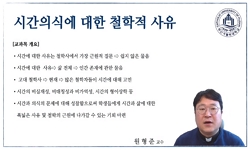본고는 시에서 시간을 의식적으로 다루거나 분명한 표지로 내세우는 경우 시간에 대한 주관적 인식이 개입되면서 특정한 시간성이 나타나는 양상을 살펴보았다. 시간을 의식적으로 다룬 ...
http://chineseinput.net/에서 pinyin(병음)방식으로 중국어를 변환할 수 있습니다.
변환된 중국어를 복사하여 사용하시면 됩니다.
- 中文 을 입력하시려면 zhongwen을 입력하시고 space를누르시면됩니다.
- 北京 을 입력하시려면 beijing을 입력하시고 space를 누르시면 됩니다.

시간을 의식적으로 다룬 시에 나타난 시간성 = A Study on Character of Time in the Poem Conscious Dealing with Time : Focused on the poem of the 1930s~1940s
한글로보기https://www.riss.kr/link?id=A103378115
- 저자
- 발행기관
- 학술지명
- 권호사항
-
발행연도
2017
-
작성언어
Korean
-
주제어
시간 ; 시간성 ; 1930년대 시 ; 1940년대 시 ; 감정이입 ; 주관적 시간성 ; 관습적 상징성 ; time ; character of time ; poem of the 1930s ; poem of the 1940’s ; empathy ; subjective time ; conventional symbolism
-
등재정보
KCI등재
-
자료형태
학술저널
- 발행기관 URL
-
수록면
251-275(25쪽)
- DOI식별코드
- 제공처
-
0
상세조회 -
0
다운로드
부가정보
국문 초록 (Abstract)
본고는 시에서 시간을 의식적으로 다루거나 분명한 표지로 내세우는 경우 시간에 대한 주관적 인식이 개입되면서 특정한 시간성이 나타나는 양상을 살펴보았다.
시간을 의식적으로 다룬 시에서 시간의 성격은 주관적인 경험 판단에 의해 형성되면서도 시간에 대한 관습적인 상징성을 따르고 있다.
1930년대의 시에서는 시간에 주관적인 감정이 이입되어 인간성이 부여되거나 감상적인 시간성이 나타나기도 하는데 이러한 양상은 특히 모더니즘 시에서 두드러지게 나타난다. 시간을 다루고 있는 이 시기의 시에서는 근대 시간에 대해 우울함, 거부감, 부정적인 인식 등의 감정을 이입하여 시간을 대상화하고 있다.
1940년대의 시에서는 시대적인 요인으로 인해 이상적 시간이 나타나고 있는데, 이때의 시간은 시간이 갖는 관습적인 상징성을 따르고 있다. 상상으로 인식할 수밖에 없는 먼 과거나 고난의 시간으로 파악되는 현재, 그리고 희망과 가능성의 시간으로 여겨지는 미래 시간은 모두 시간에 대한 관습적인 상징성을 토대로 표상된 것이다.
다국어 초록 (Multilingual Abstract)
This study looked at the poem conscious dealing with time. In the poem conscious dealing with time, the character of time is formed by subjective empirical judgements. It also follows the conventional symbolism of time. In the poem of the 1930s,...
This study looked at the poem conscious dealing with time.
In the poem conscious dealing with time, the character of time is formed by subjective empirical judgements. It also follows the conventional symbolism of time.
In the poem of the 1930s, there is a subjective feeling of belonging in time. There is also time has also been given humanity’s personality. and It appears the Sentimental time. This aspect is particularly pronounced in modernism Poetry. The poem objectification a time by incorporating feelings of depression, rejection, and negative perceptions of modern times.
In the poem of the 1940’s, there is an ideal time. The time period is followed by the conventional symbolism of time. A distant past time which can only be imagined and the present time considered the moment of adversity and future times considered the time of hope and possibility is all represented by the conventional symbolism of time.
목차 (Table of Contents)
- 국문초록
- Ⅰ. 서론
- Ⅱ. 1930년대 시에서 감정이 이입된 시간
- Ⅲ. 1940년대 시에서 관습적으로 의존하는 시간의 상징성
- Ⅳ. 결론
- 국문초록
- Ⅰ. 서론
- Ⅱ. 1930년대 시에서 감정이 이입된 시간
- Ⅲ. 1940년대 시에서 관습적으로 의존하는 시간의 상징성
- Ⅳ. 결론
- 참고문헌
- Abstract
동일학술지(권/호) 다른 논문
-
- 한국시학회
- 유성호(Yoo, Sung-Ho)
- 2017
- KCI등재
-
해방 전 임화 시의 혼성 混成적 공간 표상에 관한 고찰
- 한국시학회
- 강민규(Kang, Min-Kyu)
- 2017
- KCI등재
-
- 한국시학회
- 고봉준(Ko, Bong-Jun)
- 2017
- KCI등재
-
- 한국시학회
- 김문주(Kim, Mun-Joo)
- 2017
- KCI등재





 KCI
KCI DBpia
DBpia



